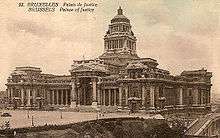Marollen
The Marolles (French) or Marollen (Dutch)[note 1] is an old neighbourhood of Brussels, situated between the Palace of Justice and the south railway station.[1] In the heart of Marollen can be found the Église de la Chapelle/Kapellekerk and the Place du Jeu de balle/Vossenplein. Major arteries of the neighborhood include the rue Haute/Hoogstraat, the rue Blaesstraat and the rue des Tanneurs/Huidevetterstraat. Inhabitants of the neighbourhood are called Marolliens. The dialect known as Marols (marollien) was spoken in this area.
History
The area now occupied by the Marollen lay, during the Middle Ages, in the first circumvallation of the city of Brussels. Lepers were exiled to this area, and they were cared for by the nuns of Maria Colentes (Marikollen). The toponym Marollen was derived from this religious group. The Marollen became a working class neighbourhood in succeeding centuries.
Development
In 1860, during the reign of Léopold I, a Royal decree announced the building of the Palace of Justice and an international architecture contest was organised for its design. The designs entered in the contest were found to be unacceptable and were thus rejected. The then minister of justice Tesch appointed Joseph Poelaert to design the building in 1861. The first stone was laid on October 31, 1866, and the building was inaugurated on October 15, 1883, after Poelaert's death.

For the building of the Palace of Justice, a section of the Marollen neighbourhood was demolished, while most of the park belonging to the House of Mérode was also expropriated. The landlords belonging to the nobility and the high bourgeoisie of Brussels received large indemnities, while the inhabitants were forced to move by the Belgian government, though they were compensated with houses in the Tillens-Roosendael garden city (cité-jardin Tillens-Roosendael) in Uccle, in the "Quartier du Chat".[2]
Poelaert himself resided in the heart of the Marolles (rue des Minimes) in a house adjoining his vast offices and workshops and communicating with them.[3]
As a result of the forced relocation of so many people, the word "architect" became one of the most serious insults in Brussels.[4] The Palace's location is on the Galgenberg hill, where in the Middle Ages convicted criminals were hanged.[4]
The 2006 Brussels riots began in this area.
Notes
References
- ↑ Marollen in Brussel
- ↑ Louis Quiévreux, Bruxelles, notre capitale: histoire, folklore, archéologie, 1951, p. 257: "Ceux qui lui donnèrent ce sobriquet, ce furent les expulsés de la «partie» des Marolles démolie afin que puisse être érigé le colosse de la place Louise. La rue des Sabots, celle de l’Artifice et d’autres encore étant condamnées, on transplanta leurs habitants dans un quartier riant et campagnard; celui du Chat, à Uccle, à la limite de Forest.
- ↑ Poelaert et son temps, Bruxelles, (catalogue exposition), 1980, p. 166: "Il habitait une maison rue des Minimes, voisine de ses bureaux et qui communiquait avec ceux-ci"
- 1 2 "Palais de Justice" (in French). Belgian federal building registry. September 29, 2009. Retrieved August 12, 2009.
External links
- De Brusselse volkswijk De Marollen is populairder dan ooit.
- Daily flea market (Voddenmarkt/Marché aux puces) at the Vossenplein/Place du Jeu de Balle in the heart of the quarter
- Tours & Walks, Brussels: De Marollen: the REAL Brussels
- Lewis, Barbara. "From lepers to art lovers, an ever-changing Brussels district." Reuters. Friday August 28, 2015. Available at The Daily Mail and available at China Daily
Coordinates: 50°50′13″N 4°20′46″E / 50.837°N 4.346°E